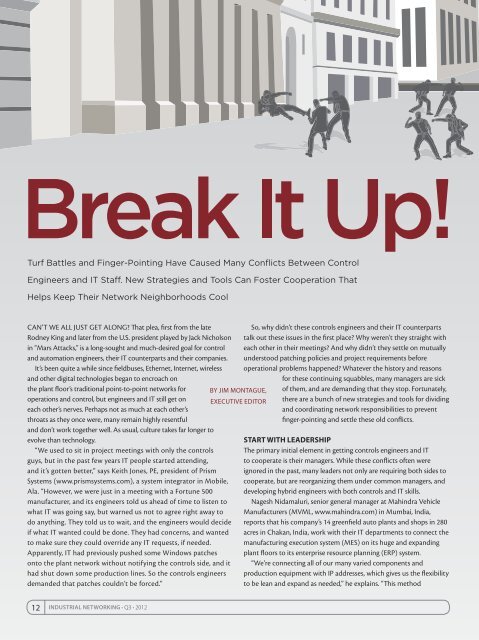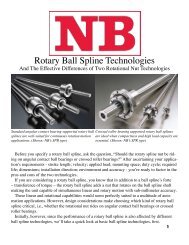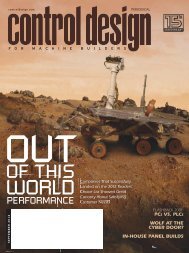ProSoft's “Phased Migration” Solutions - Control Design
ProSoft's “Phased Migration” Solutions - Control Design
ProSoft's “Phased Migration” Solutions - Control Design
Create successful ePaper yourself
Turn your PDF publications into a flip-book with our unique Google optimized e-Paper software.
Turf Battles and Finger-Pointing Have Caused Many Confl icts Between <strong>Control</strong><br />
Engineers and IT Staff . New Strategies and Tools Can Foster Cooperation That<br />
Helps Keep Their Network Neighborhoods Cool<br />
CAN’T WE ALL JUST GET ALONG? Th at plea, fi rst from the late<br />
Rodney King and later from the U.S. president played by Jack Nicholson<br />
in “Mars Attacks,” is a long-sought and much-desired goal for control<br />
and automation engineers, their IT counterparts and their companies.<br />
It’s been quite a while since fi eldbuses, Ethernet, Internet, wireless<br />
and other digital technologies began to encroach on<br />
the plant fl oor’s traditional point-to-point networks for<br />
operations and control, but engineers and IT still get on<br />
each other’s nerves. Perhaps not as much at each other’s<br />
throats as they once were, many remain highly resentful<br />
and don’t work together well. As usual, culture takes far longer to<br />
evolve than technology.<br />
“We used to sit in project meetings with only the controls<br />
guys, but in the past few years IT people started attending,<br />
and it’s gotten better,” says Keith Jones, PE, president of Prism<br />
Systems (www.prismsystems.com), a system integrator in Mobile,<br />
Ala. “However, we were just in a meeting with a Fortune 500<br />
manufacturer, and its engineers told us ahead of time to listen to<br />
what IT was going say, but warned us not to agree right away to<br />
do anything. They told us to wait, and the engineers would decide<br />
if what IT wanted could be done. They had concerns, and wanted<br />
to make sure they could override any IT requests, if needed.<br />
Apparently, IT had previously pushed some Windows patches<br />
onto the plant network without notifying the controls side, and it<br />
had shut down some production lines. So the controls engineers<br />
demanded that patches couldn’t be forced.”<br />
12 INDUSTRIAL NETWORKING � Q3 � 2012<br />
BY JIM MONTAGUE,<br />
EXECUTIVE EDITOR<br />
So, why didn’t these controls engineers and their IT counterparts<br />
talk out these issues in the fi rst place? Why weren’t they straight with<br />
each other in their meetings? And why didn’t they settle on mutually<br />
understood patching policies and project requirements before<br />
operational problems happened? Whatever the history and reasons<br />
for these continuing squabbles, many managers are sick<br />
of them, and are demanding that they stop. Fortunately,<br />
there are a bunch of new strategies and tools for dividing<br />
and coordinating network responsibilities to prevent<br />
fi nger-pointing and settle these old confl icts.<br />
START WITH LEADERSHIP<br />
Th e primary initial element in getting controls engineers and IT<br />
to cooperate is their managers. While these confl icts often were<br />
ignored in the past, many leaders not only are requiring both sides to<br />
cooperate, but are reorganizing them under common managers, and<br />
developing hybrid engineers with both controls and IT skills.<br />
Nagesh Nidamaluri, senior general manager at Mahindra Vehicle<br />
Manufacturers (MVML, www.mahindra.com) in Mumbai, India,<br />
reports that his company’s 14 greenfi eld auto plants and shops in 280<br />
acres in Chakan, India, work with their IT departments to connect the<br />
manufacturing execution system (MES) on its huge and expanding<br />
plant fl oors to its enterprise resource planning (ERP) system.<br />
“We’re connecting all of our many varied components and<br />
production equipment with IP addresses, which gives us the fl exibility<br />
to be lean and expand as needed,” he explains. “Th is method















